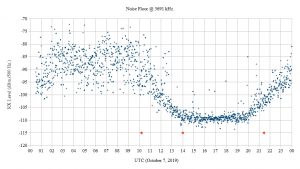Some OVMRC readers, especially those who join the Pot Hole Net on Sunday mornings, will know that there's been discussion on whether the 10 A.M. net start time is too late in the day considering that 80 metres starts to close up at around that time. The problem, it is thought, is that the D Layer, which is largely present as a result of solar UV radiation, is firmly established by the net start time so communication paths would be limited to ground wave only. Well, the discussion goes on, the net time has not changed, but after consistently seeing my TS-850 noise floor drop from S5 to S3 between 0900-1000 EDT, it led me to consider an experiment to find out just when the D Layer transitions from its day to night condition.
The setup was quite simple, just an SDR digitiser connected to my 80 metre dipole and running some software capable of snapping and storing the signal level on regular intervals. My setup had an SDRPlay RSP-2Pro digitiser and the complementary SDRUno software. The tricky part was to find a frequency slot somewhere in the 80 metre band that wouldn't be disturbed too much by traffic or QRM, 3691.000 kHz. seemed to be ok, so I tuned there and let things run over one UTC day. Here's the result:
Some supplementary information: RX mode = CW, Pre-detection BW = 500 Hz, equipment noise floor = -117 dBm. The three red diamond markers are: Ottawa Sunrise, Start of Pot Hole Net, Sunset.
The noise floor variation is rather obvious between day and night, as are the transition periods. There are a few rogue points during daylight hours which I attribute to the occasional QSO falling across the 500 Hz. test bandwidth. Even with occasional QRM, the trend is clear and there's a few things to be learned from this:
- The D Layer doesn't start building until about 60 minutes after sunrise,
- The D Layer starts to dissipate about 90 minutes before sunset,
- The larger variation in noise at night suggests more varied noise sources and lightning being "visible" from a much larger area due to F layer NVIS and skip,
- Best DX on 80 m. might be expected between 5 hours after sunset and sunrise the next day.
I think that doing this kind of experiment at this part of the 11 year solar cycle is convenient, particularly as the present null between Cycle 24-25 is quite deep with solar flux levels below 70 and there being no, or very few and small sunspots, so the solar UV level may be more consistent among measurement sessions.
At any rate, these are some results and observations for your pleasure. I think I'm going to continue taking measurements once a month until July 2020 to further characterise this effect.
73,
Hugo,
VE3KTN.

